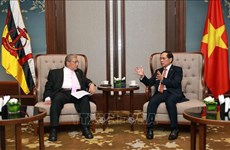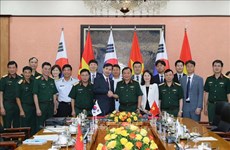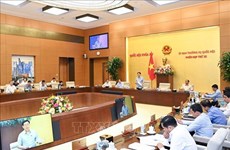Vietnam respects law in implementing oil, gas activities
Vietnam has implemented its oil and gas exploration and exploitation
totally in the country’s continental shelf and waters in a continuous
manner and in line with international law and the 1982 United Nations
Convention on the Law of the Sea (UNCLOS 1982).
Vietnam has implemented its oil and gas exploration and exploitation
totally in the country’s continental shelf and waters in a continuous
manner and in line with international law and the 1982 United Nations
Convention on the Law of the Sea (UNCLOS 1982).
As early as in 1969-1970, the then government of South Vietnam conducted seismic surveys in its continental shelf, including the Cuu Long, Nam Con Son, Ma Lai-Tho Chu and Tu Chinh-Vung May basin areas.
During 1973-1974, non-exclusive reconnaissance geophysical surveys were carried out off the shore of central Vietnam and Hoang Sa (Paracel) archipelago, which belongs to Vietnam .
Since Vietnam was reunified in 1975, the General Oil and Gas Department (now the Vietnam National Oil and Gas Group) has continued to implement legal oil and gas exploration and exploitation activities throughout the country’s exclusive economic zone and continental shelf of 200 nautical miles, as prescribed in UNCLOS 1982, which the National Assembly of Vietnam ratified in 1994.
In addition, Vietnam issued the oil and gas law in 1993 and revised and supplemented versions in 2000 and 2008.
In implementing its oil and gas activities in the country’s exclusive economic zone and continental shelf, Vietnam and its foreign partners always abide by the oil and gas law as well as related international laws. The Vietnam National Oil and Gas Group has to date signed 99 contracts in the field, of which 60 are valid.
Since 1975, the group has joined hands with its foreign partners many times to conduct seismic and non-exclusive reconnaissance geophysical surveys in the country’s continental shelf, including Hoang Sa’s waters.
Between 1993 and 1995, it conducted seismic surveys in the Tu Chinh-Vung May basin area. In 1994, the group drilled its first exploration well PV-94-2X in the basin, which belongs to Lot 134.
From 2003-2013, together with foreign contractors, the group implemented seismic survey projects in areas around Phu Khanh and Tu Chinh-Vung May basins as part of the framework of their signed agreements.
The engagement and cooperation of many foreign partners in the oil and gas exploration and exploitation activities in the East Sea proves the international community’s recognition of Vietnam ’s undeniable sovereignty, sovereign right and jurisdiction over the areas.
Since 1996, PetroVietnam has signed many agreements with foreign oil and gas firms for oil and gas exploration and exploitation in Tu Chinh-Vung May basin as well as offshore the central region. PetroVietnam and its partners have also conducted a series of 2D and 3D seismic surveys to explore the oil and gas potential in these areas.
In the Phu Khanh and Tu Chinh-Vung May basins, Vietnam has maintained normal operations despite China ’s illegal disturbances many times in various forms, including diplomatic intervention and direct sabotage in the field using aircraft and ships of all kinds.
PetroVietnam has also affirmed that in the future, it will continue its normal operations in these areas as well as other regions within the continental shelf and exclusive economic zone of Vietnam.
Recently, India ’s ONGC Videsh Ltd. (OVL) has also revealed its intention to go ahead with its plan to explore Lot 128 as part of its agreement with PetroVietnam. Earlier, the OVL received permission to extend its contract over Lot 128 by two years, so that it could finish the uncompleted work, delayed due to complex geographic and technical conditions, regardless of the groundless and perverse rejection of China .
OVL leaders said by the time the extension expires in June 2014, the OVL wishes to further lengthen the contract by one or two years to conclude its commitments stated in the contract.
The question is why the Indian partner has decided to continue the work with China conducting illegal moves intensifying tension in the East Sea? The answer is simple. The India firm is completely sure that the oil and gas lot is totally located within Vietnam’s 200-nautical mile exclusive economic zone and continental shelf.
Last year, the Russian state-run Gazprom Group signed a cooperation agreement with PetroVietnam to exploit gas in the East Sea , with Gazprom holding 49 percent of the project’s share.
The two sides have conducted exploitation in lots 05-2 and 05-3 in the East Sea with a total gas reserve of 55.6 billion cubic metres and 25.1 billion tonnes of condensate.
In response to China’s demand for Gazprom to stop its exploitation activities in the East Sea, the Foreign Ministry of Vietnam affirmed that the current joint projects between Vietnam and its foreign partners in the field of oil and gas, including those with Gazprom, are conducted within Vietnam’s exclusive economic zone and continental shelf and totally under the sovereignty and jurisdiction right of Vietnam. The projects are in conformity with international law, especially UNCLOS 1982.
Vietnam commits to and bears all responsibilities of protecting the legitimate rights and interest of foreign partners in Vietnam , stated the ministry.
At the same time, international opinion has clearly shown to be in support of Vietnam in the East Sea issue, with large-scale acknowledgement that China has behaved wrongly in terms of both words and actions.
It can be confirmed that all exploration and exploitation of the oil and gas of Vietnam , as well as the country’s cooperation activities with its foreign partners, have been conducted legally in accordance with international regulations and practices without facing any objection but the illegal disturbance from China .
All arguments against Vietnam ’s oil and gas exploration and exploitation arbitrarily given by China are totally ungrounded, which is actually China ’s excuse for its illegal placement of its Haiyang Shiyou-981 in the waters of Vietnam as part of its scheme to monopolise the East Sea .
At the beginning of May, the China National Offshore Oil Corporation illegally dispatched and positioned the rig at 15 degrees 29 minutes 58 seconds north latitude and 111 degrees 12 minutes 06 seconds east longitude. According to UNCLOS 1982, the location is deep inside Vietnam ’s waters.
Since being illegally placed in Vietnam ’s waters, the oil rig continued to be moved, but still deep into Vietnam ’s exclusive economic zone and continental shelf.
According to Nguyen Hong Thao, former Deputy Chairman of the National Boundary Commission under the Foreign Ministry, the rig location is about 130 nautical miles from the Vietnamese coast and 119 nautical miles from Ly Son Island, in central Vietnam, and 17 and 103 nautical miles from Tri Ton Reef and Phu Lam island, respectively, in Hoang Sa archipelago. It is also 182 nautical miles from China ’s Hainan coast.
As prescribed in UNCLOS 1982, the area where China illegally stationed its rig is deep inside the exclusive economic zone and continental shelf of Vietnam .
Hoang Sa is the archipelago Vietnam claimed sovereignty over in the 17th century, but China used force to occupy all the islands in 1974. International law bans the use of force and thus does not recognise occupation of a territorial area through the use of force. China in 1996 declared a baseline for the archipelago, with Tri Ton reef being the farthest point to the southwest of this baseline. This claim faced global criticism due to the fact that the archipelago is being disputed. However, China insists that it has sovereignty over Hoang Sa (or Xisha, as it calls it) without any dispute and refuses to talk.
More seriously, in July 2012, China declared the establishment of a so-called Sansha city with its headquarters in Phu Lam Island which has control over the sea area in the so-called nine-dash line which accounts for 80 percent of the East Sea.
Under Article 121 (3) of the 1982-UNCLOS, reefs or rocks un able to sustain human habitation or economic activities of its own like Tri Ton are not entitled to a 200 nautical mile exclusive economic zone and continental shelf. They can only have a 12 nautical mile territorial water at most.
Vietnam will never accept these acts of China.-VNA
As early as in 1969-1970, the then government of South Vietnam conducted seismic surveys in its continental shelf, including the Cuu Long, Nam Con Son, Ma Lai-Tho Chu and Tu Chinh-Vung May basin areas.
During 1973-1974, non-exclusive reconnaissance geophysical surveys were carried out off the shore of central Vietnam and Hoang Sa (Paracel) archipelago, which belongs to Vietnam .
Since Vietnam was reunified in 1975, the General Oil and Gas Department (now the Vietnam National Oil and Gas Group) has continued to implement legal oil and gas exploration and exploitation activities throughout the country’s exclusive economic zone and continental shelf of 200 nautical miles, as prescribed in UNCLOS 1982, which the National Assembly of Vietnam ratified in 1994.
In addition, Vietnam issued the oil and gas law in 1993 and revised and supplemented versions in 2000 and 2008.
In implementing its oil and gas activities in the country’s exclusive economic zone and continental shelf, Vietnam and its foreign partners always abide by the oil and gas law as well as related international laws. The Vietnam National Oil and Gas Group has to date signed 99 contracts in the field, of which 60 are valid.
Since 1975, the group has joined hands with its foreign partners many times to conduct seismic and non-exclusive reconnaissance geophysical surveys in the country’s continental shelf, including Hoang Sa’s waters.
Between 1993 and 1995, it conducted seismic surveys in the Tu Chinh-Vung May basin area. In 1994, the group drilled its first exploration well PV-94-2X in the basin, which belongs to Lot 134.
From 2003-2013, together with foreign contractors, the group implemented seismic survey projects in areas around Phu Khanh and Tu Chinh-Vung May basins as part of the framework of their signed agreements.
The engagement and cooperation of many foreign partners in the oil and gas exploration and exploitation activities in the East Sea proves the international community’s recognition of Vietnam ’s undeniable sovereignty, sovereign right and jurisdiction over the areas.
Since 1996, PetroVietnam has signed many agreements with foreign oil and gas firms for oil and gas exploration and exploitation in Tu Chinh-Vung May basin as well as offshore the central region. PetroVietnam and its partners have also conducted a series of 2D and 3D seismic surveys to explore the oil and gas potential in these areas.
In the Phu Khanh and Tu Chinh-Vung May basins, Vietnam has maintained normal operations despite China ’s illegal disturbances many times in various forms, including diplomatic intervention and direct sabotage in the field using aircraft and ships of all kinds.
PetroVietnam has also affirmed that in the future, it will continue its normal operations in these areas as well as other regions within the continental shelf and exclusive economic zone of Vietnam.
Recently, India ’s ONGC Videsh Ltd. (OVL) has also revealed its intention to go ahead with its plan to explore Lot 128 as part of its agreement with PetroVietnam. Earlier, the OVL received permission to extend its contract over Lot 128 by two years, so that it could finish the uncompleted work, delayed due to complex geographic and technical conditions, regardless of the groundless and perverse rejection of China .
OVL leaders said by the time the extension expires in June 2014, the OVL wishes to further lengthen the contract by one or two years to conclude its commitments stated in the contract.
The question is why the Indian partner has decided to continue the work with China conducting illegal moves intensifying tension in the East Sea? The answer is simple. The India firm is completely sure that the oil and gas lot is totally located within Vietnam’s 200-nautical mile exclusive economic zone and continental shelf.
Last year, the Russian state-run Gazprom Group signed a cooperation agreement with PetroVietnam to exploit gas in the East Sea , with Gazprom holding 49 percent of the project’s share.
The two sides have conducted exploitation in lots 05-2 and 05-3 in the East Sea with a total gas reserve of 55.6 billion cubic metres and 25.1 billion tonnes of condensate.
In response to China’s demand for Gazprom to stop its exploitation activities in the East Sea, the Foreign Ministry of Vietnam affirmed that the current joint projects between Vietnam and its foreign partners in the field of oil and gas, including those with Gazprom, are conducted within Vietnam’s exclusive economic zone and continental shelf and totally under the sovereignty and jurisdiction right of Vietnam. The projects are in conformity with international law, especially UNCLOS 1982.
Vietnam commits to and bears all responsibilities of protecting the legitimate rights and interest of foreign partners in Vietnam , stated the ministry.
At the same time, international opinion has clearly shown to be in support of Vietnam in the East Sea issue, with large-scale acknowledgement that China has behaved wrongly in terms of both words and actions.
It can be confirmed that all exploration and exploitation of the oil and gas of Vietnam , as well as the country’s cooperation activities with its foreign partners, have been conducted legally in accordance with international regulations and practices without facing any objection but the illegal disturbance from China .
All arguments against Vietnam ’s oil and gas exploration and exploitation arbitrarily given by China are totally ungrounded, which is actually China ’s excuse for its illegal placement of its Haiyang Shiyou-981 in the waters of Vietnam as part of its scheme to monopolise the East Sea .
At the beginning of May, the China National Offshore Oil Corporation illegally dispatched and positioned the rig at 15 degrees 29 minutes 58 seconds north latitude and 111 degrees 12 minutes 06 seconds east longitude. According to UNCLOS 1982, the location is deep inside Vietnam ’s waters.
Since being illegally placed in Vietnam ’s waters, the oil rig continued to be moved, but still deep into Vietnam ’s exclusive economic zone and continental shelf.
According to Nguyen Hong Thao, former Deputy Chairman of the National Boundary Commission under the Foreign Ministry, the rig location is about 130 nautical miles from the Vietnamese coast and 119 nautical miles from Ly Son Island, in central Vietnam, and 17 and 103 nautical miles from Tri Ton Reef and Phu Lam island, respectively, in Hoang Sa archipelago. It is also 182 nautical miles from China ’s Hainan coast.
As prescribed in UNCLOS 1982, the area where China illegally stationed its rig is deep inside the exclusive economic zone and continental shelf of Vietnam .
Hoang Sa is the archipelago Vietnam claimed sovereignty over in the 17th century, but China used force to occupy all the islands in 1974. International law bans the use of force and thus does not recognise occupation of a territorial area through the use of force. China in 1996 declared a baseline for the archipelago, with Tri Ton reef being the farthest point to the southwest of this baseline. This claim faced global criticism due to the fact that the archipelago is being disputed. However, China insists that it has sovereignty over Hoang Sa (or Xisha, as it calls it) without any dispute and refuses to talk.
More seriously, in July 2012, China declared the establishment of a so-called Sansha city with its headquarters in Phu Lam Island which has control over the sea area in the so-called nine-dash line which accounts for 80 percent of the East Sea.
Under Article 121 (3) of the 1982-UNCLOS, reefs or rocks un able to sustain human habitation or economic activities of its own like Tri Ton are not entitled to a 200 nautical mile exclusive economic zone and continental shelf. They can only have a 12 nautical mile territorial water at most.
Vietnam will never accept these acts of China.-VNA













